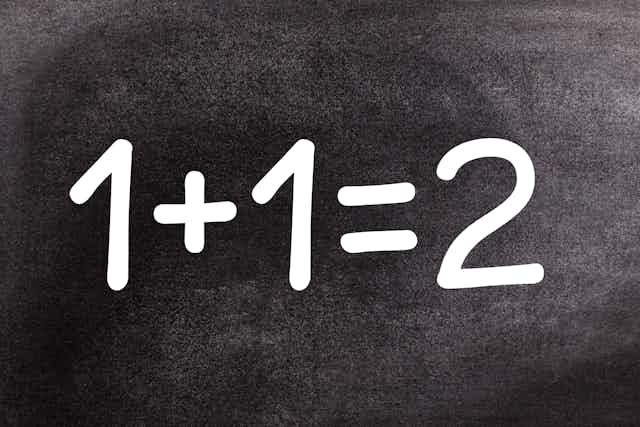Explicit instruction is a term that summarises a type of teaching in which lessons are designed and delivered to novices to help them develop readily-available background knowledge on a particular topic.
Explicit instruction emerged out of research conducted in the 1960s and 1970s. Researchers sat at the back of classrooms and looked for relationships between particular behaviours of effective teachers and their students’ academic performance.
This research found teachers with the best results spent more time reviewing previously learned concepts, checking whether students had understood concepts and correcting misconceptions during the lesson. Explicit teaching practices involve showing students what to do and how to do it.
Like baking a cake, explicit instruction is a step-by-step process where deviating from the recipe or omitting ingredients can have an underwhelming result.

This is contrasted to a type of learning where, before students are shown the essential information, they are asked to practise a task, and then discover and construct some or all of the essential information themselves. This is sometimes known as inquiry-based learning.
It can be useful for someone who wants to conduct an experiment to learn about evaporation and condensation, provided they already understand the nature of solids, liquids and gases and how to safely use a Bunsen burner.
We remember what we think about
Explicit instruction is also known as “fully guided” practice. Teachers who follow an explicit approach explain, demonstrate and model everything: from blending sounds together to decode words, to writing a complex sentence with figurative language, to kicking a football.
While some students achieve success quickly, others need far more opportunities for practice. Explicit instruction teachers provide daily reviews of previously learned knowledge and skills so they become automatic. Then they can be applied to more complex tasks such as reading, writing a short story or playing a game of AFL.
Explicit instruction is underscored by a learning theory known as the information processing model. It is based on the assumption we only remember what we think about, and keep thinking about. If you can still remember your childhood telephone number, it’s probably because of the number of times you have used and retrieved that information.
Read more: Comic explainer: how memory works
It’s well known there is a limit to how much new information the human brain can process and how much can be stored in our long-term memory. These understandings form something known as cognitive load theory, which adds further value to the effectiveness of explicit instruction.

Put simply, knowing precursor maths skills – such as times-tables and the difference between the numerator and denominator – reduces the strain on the limited space you have in your brain. So it might free up some brain space to learn about more complex maths, such as simplifying fractions.
Particular models fall under the umbrella term of explicit instruction in Australia and include: explicit instruction, explicit direct instruction, Direct Instruction and I do, we do, you do. These models are based on similar instructional principles and refer to specific lesson design and delivery components.
Read more: Direct Instruction and the teaching of reading
Direct Instruction, for instance, consists of a suite of commercially available teaching resources developed from the work of US educator Siegfried Engelmann in the 1960s. It is a highly scripted model, which is both a reason some teachers perceive the approach as inflexible, and the reason it is effective. When followed with fidelity, direct instruction has been shown to work. The model has proven quite effective when applied in remote aboriginal communities.
Explicit instruction, however, is not scripted. This means there is often variability between the way teachers use it and of the component parts of this approach. This also makes definitive statements on its efficacy problematic.
So, what’s the controversy?
Since the late 1970s, more child-centred approaches have been the prevailing orthodoxy in teacher education and curriculum design in Australia. These approaches include discovery learning and inquiry. They are based on a theory of learning called constructivism, that sees learning as an active process.
Teachers following a constructivist approach provide learning opportunities that enable students to come to their own unique understandings of what is being taught. Constructivism is popular and prevalent because it personalises learning, emphasises the active construction of knowledge and privileges hands-on learning to solve real-world problems.
Critics of explicit instruction typically argue it is a deficit model that sees students sitting passively in rows all day engaging in rote learning. This is a misunderstanding of explicit instruction, which – when done properly – is engaging and rarely done for extended periods of time.

It’s true the model requires students to face the teacher. This is because the process involves the teacher asking a lot of questions. She or he may also ask children to write on mini-whiteboards to show their understanding during the lesson.
Arguments that explicit instruction doesn’t allow teachers to cater for range of student abilities are also ill-founded. Explicit instruction allows teachers to teach the same concept to students but differentiate at the point of individual practice.
Read more: Learning languages early is key to making Australia more multilingual
For example, after teaching the algorithm for subtraction, students will have the same time to solve problems of increasing difficulty. But not all students will follow the same process. While some students will only solve (29-13), others might solve (189-101) and (1692-1331).
As adults learning to abseil or skydive, we prefer it when information is broken down into manageable chunks, the instructor checks for understanding and we are given opportunities to practise the skills we’ll need before we step over the edge. There is a place for explicit instruction in Australian classrooms, particularly when background knowledge is low and the task is difficult.

